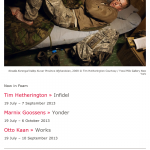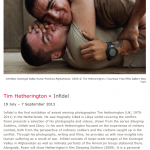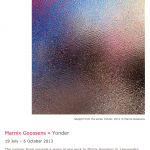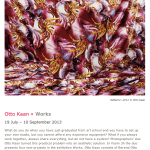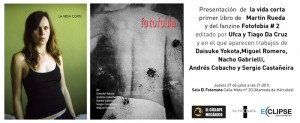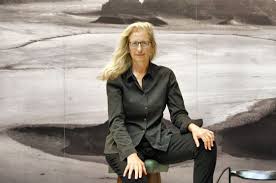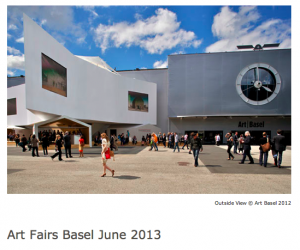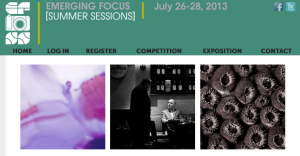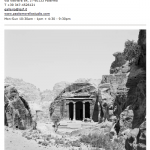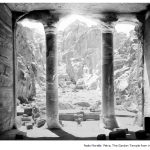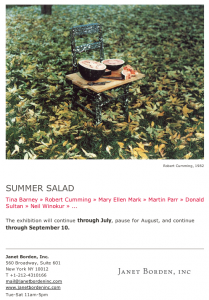
7 junio, 2016
19 julio, 2013
SUMMER SALAD Exposición en la sala Janet Borden, New York: Tina Barney, Robert Cumming, Mary Ellen Mark, Martin Parr, Donald Sultan, Neil Winokur…
Now in Foam: Tim Hetherington; Marnix Goossens y Otto Kaan
Emerging Focus Photo Seminars/Tours – Last Week!
We are proud to announce the EMERGING FOCUS [SUMMER SESSIONS] July 2013, will be partnering with photo l.a. & Aesthesia Studios in Culver City, Los Angeles. This three day event will showcase over 20 seminars spanning a range of photography topics from fine art and commercial photography, tips and techniques, to hands-on training from leading experts.
Photo Nomad Tours:
Historic Santa Monica: A Photo Tour with Helen K. Garber
The Boulevard of Dreams: A Photo Tour of Hollywood Boulevard with Susan Burnstine
A Walk Down Broadway: A Photo Tour of Historic Downtown with Ted Meyer
Gallery Tour Culver City & Bergamont Station: A Docent Tour with Julie Novakoff Smith
Creative Seminars:
Keys to Great Travel Photography: And How to Get it Published, with Fred Roberts & Christopher Robinson
Fashion Photography with David Jakle
Portrait Photography with David Jakle
Open Show LA & EMERGING FOCUS Competition Winners
Technical Seminars:
Perfect Your Photography from Shoot to Finish in the New Adobe Lightroom 5 with Natasha Calzatti
After the Shoot: Portrait Retouching Techniques in Photoshop CS6 with Natasha Calzatti
Multiple Speedlite Flash With Canon Representative Michael Monezis
Digital Imaging, the Next Level: Fine Art Printing with Raw Files With Canon Representative Michael Monezis
The Print Matters: The World of Inkjet Paper with Eric Joseph from Freestyle Photographic Supplies
25 junio, 2013
Presentación de “La vida corta”, primer libro de Martín Rueda; y del fanzine Fotofobia #2, editado por Ufca y Tiago Da Cruz en El Fotómata.
Premio Principe de Asturias a Annie Leibovitz
Hace unos días un conocido me pregunto que que me parecía que le hubieran dado un premio Príncipe de Asturias a una fotógrafa. Titubee un poco antes de contestarle. Quería hacerlo simplificando lo que pensaba por no aburrirlo demasiado con mis diatribas. Se me ocurrió que quizás, y como en otras ocasiones, un ejemplo literario ayudaría a que mi interlocutor entendiera lo que quería expresarle. El conocimiento sobre lo fotográfico, en entornos fuera de su propio ambiente, no suele ir más allá del reconocimiento estético o documental de las imágenes que proliferan en los medios de comunicación de masas. En cambio la literatura suele tener muchos más seguidores con un nivel de información y preparación suficiente como para ejercer el sentido crítico sobre aquello que leen y sobre aquellos que escriben.
Reconocí, antes de seguir con mi reflexión, que era una alegría que la fotografía obtuviera un premio de este tipo a través de esta autora. Todo lo que da prestigio y reconocimiento a nuestro medio ayuda a despertar el interés por él, y en este caso, a tenerlo en cuenta como parte importante de nuestra capacidad de creación y comunicación.
Pero, y aquí venía el meollo de la cuestión, le dije que que le parecería que le hubieran dado el Nobel de Literatura a Ken Follet en vez de a García Márquez. También le comenté que si conocía los nombres de los últimos Nobel de literatura, datos que tampoco conocía yo, Mo Yan en 2012 y tomas Transtroner en 2011. Autores a los cuales no habíamos leído nunca. Supongo que es fácil entender donde quería llegar.
Creo que hay que separar la excelencia del éxito, o por lo menos de la consideración más económica o chabacana de la palabra éxito.
Dios me libre, si en algún sitio está, durmiendo una siesta eterna por lo que vemos, de descalificar el trabajo y el esfuerzo de Annie Leibovitz y, por supuesto, reconozco mi envidia absoluta a su éxito. Pero a muchos de los que vivimos alrededor de este medio se nos vienen a la cabeza otros nombres llenos de eso a lo que he llamado excelencia y Annie no está en ese grupo.
A Annie le han concedido el Premio Príncipe de Asturias de Comunicación y Humanidades por considerar que su labor creadora o de investigación representa una aportación relevante a la cultura universal en esos campos.
Si los aportes a la cultura se miden en relación a la cantidad de personas que conocen tu obra podemos decir que tanto ella como Ken Follet se merecen el premio. Pero si ese aporte se mide en relación a otros parámetros más relacionada con la labor creadora y de investigación me pongo a pensar inmediatamente en que Robert Frank aun vive, aunque a niveles de popularidad general puede que lo conozca menos gente que al propio Mo Yan.
Todo esto nos hace preguntarnos quienes son aquellos que deciden sobre quien recaen los premios y que conocimientos tienen del medio al que premian. También podemos preguntarnos que es lo que realmente se premia o que influye en los premios más allá del trabajo del premiado.
Quizás el hecho de que la fallecida Susang Sontag fuera su pareja y también galardonada con un Príncipe de Asturias haya influido un poco.
Aunque yo me pregunto si Susang la habría elegido.
Pero quedémonos con el principio y estemos contentos de que la fotografía se merezca un Príncipe de Asturias.
Y para terminar os dejo aquí el acta del jurado para vuestro deleite.
Martín Rueda
http://www.rtve.es/contenidos/documentos/Acta_Comunicaci%C3%B3n_2013.pdf
14 junio, 2013
Feria de Arte de Basilea. Junio 2013
12 junio, 2013
Emerging Focus: Summer sessions. 26 a 28 de julio de 2013
We are proud to announce the EMERGING FOCUS [SUMMER SESSIONS] July 26-28 2013, will be partnering with photo l.a. & Aesthesia Studios, Los Angeles. This three day event will showcase over 20 seminars on a range of photography topics from the business of photography, fine art and commercial photography, tips and techniques hands on training from leading experts through to photography tours throughout Los Angeles. In addition, amazing evening events, tours of local fine art photography galleries, and more!
Photo Nomad Tours offer a variety of ways to improve your photography skills with the guidance of internationally renowned photographers who have made their homes in these incredible LA neighborhoods. During these unique expeditions you’ll learn tips and techniques while exploring picturesque locations. All our photography programs are designed for professionals, and advance amateurs of all levels who are interested in improving their skills while exploring Los Angeles
International ArtExpo: Liquid Borders, Bari, July 2013
Liquid Borders | Bari 2013
“La Corte – Fotografia e ricerca” cultural organization and International ArtExpo are proud to announce the opening of Liquid Borders – International art festival of photography, video art and installation, held in Bari (Italy) in the prestigious and historical locations of Castello Svevo (Swabian Castle), Santa Teresa dei Maschi and Sala Murat, from the 3rd to the 31st of July.
The press conference will be on Friday the 28th of June 2013 at 11.30 AM, in the Multimedia Hall of Castello Svevo (Swabian Castle).
The openings of the event will be on Wednesday the 3rd of July 2013 at Castello Svevo (Swabian Castle), at 06.00 PM; and on Thursday the 4th of July 2013 in Santa Teresa dei Maschi at 05.00 PM, and at Sala Murat at 06.00 PM.
The event will last until July 31st 2013.
The Festival is based on the main concept of the hybridization among art, culture, physical and social identities in contemporary cities, and the mixing between people and space. Urban environments, people, rules and limits are no more distinct realities, but they constantly modify and get mixed together, generating new connections and hybrid results, with undefined ethic, social, sexual and religious borders. Thirty-nine artists, from all over the world, have been invited to present their artworks related to the theme, during the festival which will be hosted in the three venues of the city of Bari, until the end of July. The aim of the festival is to understand which are the borders still alive in contemporary metropolis, and which ones have become undefined and hybrid. To understand that, artists use material, pictures, sounds, videos and site-specific installations. Fausta Maria Bolettieri and Luca Curci, curators.
In the Sala Sveva, at the ground floor of Castello Svevo, will be projected the video “Solipsist” by Andrew Thomas Huang, American filmmaker and artist, showcased at the Museum of Contemporary Art in Los Angeles (USA), the Saatchi & Saatchi New Directors Showcase at Cannes Lions (France), the Hammer Museum (USA), MOCA Taipei (Taiwan), the ZKM Media Museum in Karlsruhe (Germany) and the ASVOFF festival at Centre Pompidou in Paris (France). His short film “Solipsist“ was honoured at the Saatchi & Saatchi New Directors Showcase at Cannes Lions and won Best Experimental Short Film at the Slamdance Film Festival. The film caught the attention of Icelandic polymath Bjork, leading Andrew to direct her music video for “Mutual Core”, premiering at the Museum of Contemporary Art in Los Angeles (USA).
Furthermore the projection will include the video-architecture works “Ordos”, “Absolute Towers” and “Fish Tank” by MAD architects, founded in 2004 by Ma Yansong, the studio has been awarded the 2011 RIBA international fellowship. Among all the futuristic project realized by MAD architects: the Absolute Towers in Toronto (Canada), the China Wood Sculpture Museum (China), the Harbin Culture Island in Harbin (China) and the Ordos Museum (Inner Mongolia).
http://www.lucacurci.com/artexpo/
International ArtExpo
Corso Vittorio Emanuele II, 33
70122 Bari (Italy)
+39.0805234018
+39.3387574098
internationalartexpo@gmail.com
www.lucacurci.com/artexpo
Paolo Morello expone “Petra” en Scuderie di Palazzo Sambuca en Palermo
Petra in ancient Times
The oldest settlements in the area of Petra were inhabited by the Edomites – who were mentioned in the Book of Exodus – between the end of the VIII century and the beginning of the VII century BC. The town flourished a little later on thanks to the Nabataeans, an Arab nomadic tribe. In the first half of the II century BC the Nabataeans gave life to their kingdom, establishing in Petra their capital. Its ascent was mainly due to three different factors: the orography, which made it unconquerable, the abundance of water, and, most of all, the location. For several centuries Petra was the crossroads of the caravan routes from Aqaba and Yemen to Damascus and to Constantinople, which is to say, to all of the trade routes leading to a variety of goods – spices, incense, perfumes, and tar – from India to the Mediterranean countries and from Egypt to Persia.
The first king of the Nabataeans of whom we have recorded evidence was ‘Ubayda I (known also as Obodas I), who ruled from 96 BC to 85 BC. After his death, he was worshiped as a god, and the most sumptuous grave in Petra was very likely dedicated to him, the so called al-Deir (the Monastery). Around 80 BC, the Nabataeans conquered the Seleucid territories, extending their domain northward as far as the Euphrates river and Palmyra. The son of ‘Ubayda I, al-Harith III (Areta III), expanded their kingdom further, all the way to Damascus. The other famous grave in Petra, al-Khazneh (the Treasury), which owes its name to the mistaken belief that the treasure of an Egyptian Pharaoh was hidden in it, is most likely dedicated to al-Harith III. Al-Harith’s greatest success was the agreement he negotiated with the Romans: by paying a huge toll in silver, the Nabataean kingdom ensured its substantial independence. Petra grew in power and wealth from 9 BC to 40 AD under king al-Harith IV, when its population reached about 30,000 people. Toward the end of the I century AD, the Romans shifted their trade routes to Egypt and along the Nile river; new towns became pivotal along the caravan routes, such as Bosra and Palmyra in Syria. In 106 AD the Nabataean kingdom was peacefully taken over by Rome. Bosra became the new capital of the Roman province called Arabia Petræa and from then on, Petra’s slow decline began.
